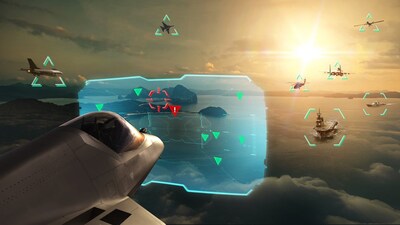Despite Magnetic Fields' Best Efforts, Star Formation Continues in 30 Doradus
WASHINGTON, June 8, 2023 /PRNewswire/ — New research from the Stratospheric Observatory for Infrared Astronomy (SOFIA), whose science mission operations were managed by Universities Space Research Association, has shown that the magnetic fields in 30 Doradus — a region of ionized hydrogen at the heart of the Large Magellanic Cloud — could be the key to its surprising behavior. The researchers determined how star formation can continue in the region despite its strong magnetic fields.
Most of the energy in 30 Doradus, also called the Tarantula Nebula, comes from the massive star cluster near its center, R136, which is responsible for multiple, giant, expanding shells of matter. But in this region near the nebula’s core, within about 25 parsecs of R136, things are a bit weird. The gas pressure here is lower than it should be near R136’s intense stellar radiation, and the area’s mass is smaller than expected for the system to remain stable.
Using SOFIA’s High-resolution Airborne Wideband Camera Plus (HAWC+), astronomers studied the interplay between magnetic fields and gravity in 30 Doradus. Magnetic fields, it turns out, are the region’s secret ingredient.
The recent study, published in The Astrophysical Journal, found the magnetic fields in this region are simultaneously complex and organized, with vast variations in geometry related to the large-scale expanding structures at play.
But how do these complex-but-organized fields help 30 Doradus survive?
In most of the area, the magnetic fields are incredibly strong. They’re strong enough to resist turbulence, so they can continue to regulate gas motion and hold the cloud’s structure intact. They’re also strong enough to prevent gravity from taking over and collapsing the cloud into stars.
However, the field is weaker in some spots, enabling gas to escape and inflate the giant shells. As the mass in these shells grows, stars can continue to form despite the strong magnetic fields.
Observing the region with other instruments can help astronomers better understand the role of magnetic fields in the evolution of 30 Doradus and other similar nebulae.
About SOFIA
SOFIA was a joint project of NASA and the German Space Agency at DLR. DLR provided the telescope, scheduled aircraft maintenance, and other support for the mission. NASA’s Ames Research Center in California’s Silicon Valley managed the SOFIA program, science, and mission operations in cooperation with the Universities Space Research Association, headquartered in Columbia, Maryland, and the German SOFIA Institute at the University of Stuttgart. The aircraft was maintained and operated by NASA’s Armstrong Flight Research Center Building 703, in Palmdale, California. SOFIA achieved full operational capability in 2014 and concluded its final science flight on Sept. 29, 2022.
About USRA
Universities Space Research Association (USRA) is a nonprofit corporation chartered to advance space-related science, technology and engineering. USRA operates scientific institutes and facilities and conducts other major research and educational programs. USRA engages the university community and employs in-house scientific leadership, innovative research and development, and project management expertise. More information about USRA is available at www.usra.edu.
© 2023 Universities Space Research Association
425 3rd Street SW, Suite 950, Washington DC, 20024
Contact:
Suraiya Farukhi
[email protected]
443-812-6945
![]() View original content to download multimedia:https://www.prnewswire.com/news-releases/despite-magnetic-fields-best-efforts-star-formation-continues-in-30-doradus-301846352.html
View original content to download multimedia:https://www.prnewswire.com/news-releases/despite-magnetic-fields-best-efforts-star-formation-continues-in-30-doradus-301846352.html
SOURCE Universities Space Research Association




 Private Internet Access gives you unparalleled access to thousands
of next-gen servers in over 83 countries and each US state. Your
VPN experience will always be fast, smooth, and reliable.
Private Internet Access gives you unparalleled access to thousands
of next-gen servers in over 83 countries and each US state. Your
VPN experience will always be fast, smooth, and reliable.

